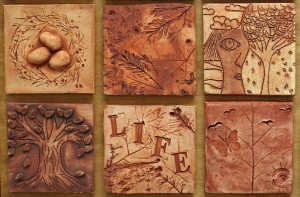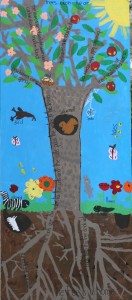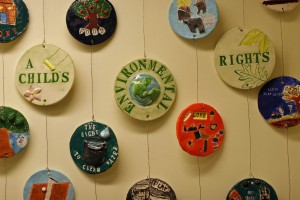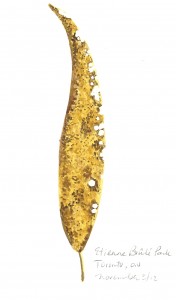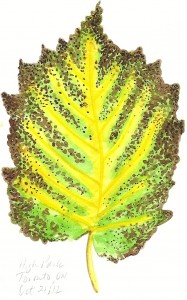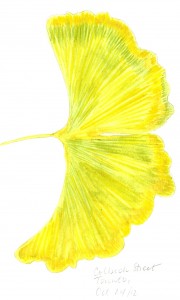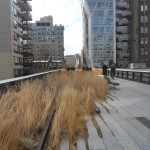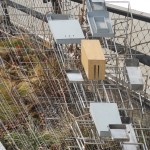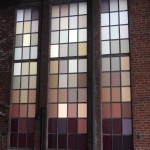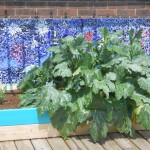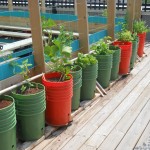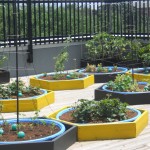Toronto has been the site of an innovative project on climate change and sustainability this fall, organized by the team at Cape Farewell [http://www.capefarewell.com/]. Started up by artist David Buckland in 2001 as a way to bring artists and scientists together to address climate change, Cape Farewell uses ãthe notion of expedition – Arctic, Island, Urban and Conceptual – to interrogate the scientific, social and economic realities that lead to climate disruption, and to inspire the creation of climate focused artã (from their website).ô The variety of projects this group has created internationally is fascinating, from trips to the Arctic, to art/science exhibitions, books, websites, performances and other cultural events.ô ô The Cape Farewell Foundation now has a Toronto office, which has led to a months-long cultural festival focused on climate change, and culminates in a conference here in February.ô For more on the range of events that they are hosting, visit http://www.capefarewellfoundation.com/projects/carbon-14.html
TED Talks on Environmental Art-making
Iãve been finding some great TED talks related to environmental art-making that I wanted to share:
Natalie Jeremijenko is a prof at NYU, and runs something she calls the ãEnvironmental Health Clinicã which features ãcreative health solutionsã for the environment.ô Her art projects are certainly creative, sometimes digital and often humourous ã well worth viewing.ô
Bjarke Ingels is a Danish architect who designs buildings that have a naturalistic design with stunning views – and perform nature-like functions to make them sustainable.
Canadian artist Edward Burtynsky won the 2005 TED prize for his large scale photos of some of the worldãs most challenging environmental issues, from quarries in Italy, to shipyards in Bangladesh, to the tar sands in Canada.ô
Margaret Wertheim works with her sister Christine to raise awareness about the environmental challenges facing the worldãs coral reefs, achieved through an interdisciplinary, interactive project that uses math, biology, and crocheting.
Iãm sure there are others, but these are my favourites so farãÎinspiring takes on what can happen when you bring creativity and environmental activism together!
The Environmental Angels Project
June proved to be a very busy month, full of environmental artmaking both inside OISE and in our partner schools.ô I was fortunate to be asked to do an inaugural eco-art project at Holy Angels Catholic School in Toronto’s west end this spring, and wanted to share the results.ô
ô This project was intended as a way to get the school community thinking more sustainably by starting a schoolyard collection of student eco-artwork.ô As the theme of angels runs deep in this school, we came up with the idea of focusing on the importance of stewardship by asking students to think about what they want to protect in the local environment.ô The students from classes in grades four and eight worked in pairs to photograph features of their neighbourhood that they value, and then used these to inform large scale drawings.ô The drawings were then traced onto plywood, cut out with a jigsaw, and painted by the pairs of young artists together.ô The resulting installation covers both side of the school fence.ô To finish, students wrote poems about the images in their paintings, shared in a poetry slam.
ô Despite the school being on the edge of an industrial zone on one side, and a suburban neighbourhood on the other, the student artists all chose natural features of their neighbourhood as the subjects of their paintings, from plants and trees to squirrels and snails.ô A few thought about the ‘big picture’ by focusing on water, the sky, or the sun.ô And they seemed to get the concept that the same practices used by environmental artists (like reducing waste, decreasing material toxicity, and cleaning up the mess you make) could be used by all of us to better protect the local environments in which we live.ô I hope this learning about stewardship will stay with them in the years to come.
Celebrating Eco-Art Installations at OISE
ô May and June were busy months at OISE for environmental and sustainability ed – one of our success stories was to get four new environmental art projects up on the walls.ô These have been in development for about six months (check out my blog entries in December and February that track their creation.)ô I’m happy to be able to share some of the images of these works below, but you can see lots more on our OISE website (www.oise.utoronto.ca/eseô ). Look in theô ESE in Practice section.ô
ô The response to the artworks has been very positive; many people have told me that they have climbed the stairs looking for others, and that they love having children’s art in the building.ô The B.Ed students were thrilled at how good their work looks, as have others using the subway entrance, where it hangs.ô My favourite response has come from the grade 1 students who created the tree paintings; they wanted to climb up all 12 flights of stairs at OISE to celebrate their contribution to the ‘Take the Stairs’ campaign (and they did!)ô The most frequent response we have been hearing to these works has been “They are wonderful, when are we getting more?!”ô
ô Certainly these projects have all been challenging to collaboratively create, but worth the effort.ô The B.Ed students who worked on them have had a positive and rewarding learning experience, and the young students who were involved feel very proud that their work is on display in a public institution.ô The installations also appear to be a good way to remind our community about the power of art to capture attention and raise awareness about environmental issues.ô But the big question left hanging is whether they will actually change people’s behaviour, be it to take the stairs more frequently, to turn off a light, or to live more consciously (and sustainably) on the earth.ô So while these works may lead to more eco-artworks at OISE, they may also lead to my next research project…stay tuned!
World Premiere of My Eco-Art Video!
Such a busy winter, but so many fun projects happening along the way!ô I started my own You Tube channel called ãEcoArt Edã, and posted my first video about making ecoart with elementary children.ô You can find it here:
http://www.youtube.com/watch?v=3PhYowsFGNM
The project came about thanks to my sister Karen Somers, who is a filmmaker and photographer in LA (check out her website at http://www.karensomers.com/ )ô We shot the footage last summer when she was in town ã a fitting end as I was wrapping up a long standing commitment to the school featured in the video.ô We didnãt have time to script, so we shot mainly in one or two takes when we had time.ô She left me the raw footage, and I worked on editing it last fall.ô It was my first experience using iMovie, so the learning curve was steep, but Iãm pleased with the result.ô (Thanks also to my son Alex for his help with the editing ã it really was a family affair!)ô It certainly has reminded me to document all that is done when working on ecoart projects ã just sharing the results with others can inspire them to try eco-artmaking themselves!
Teaching and Learning in the OISE Eco-art Projects
No time to blog last month – weãre midway on the OISE eco-art projects, and it’s been busy!ô Weãve got four projects underway, thanks to efforts of my dedicated students, as I couldnãt have done that many on top of teaching and research duties this last month.ô Iãm working on a nature-based mural project with a class of grade 1s at our lab school, the Institute of Child Study, in collaboration with the art teacher, Tara Rousseau.ô We have 2 8 ft. high murals underway with the students, demonstrating what they have learned about tree habitats this last fall.ô Tara and I have also been working alongside OISE student Stephanie Heim and a grade six class who are creating a clay tile installation based on the Environmental Rights of Children, and OISE student Hayley Chown, who has been working with the grade 5s to create energy conservation stickers for the light switches at OISE.ô Another team of OISE students, Aidan Hammond, Wynette Tavares and Nikolaos Katsiou, are running eco-art workshops to explore their fellow studentsã conceptions of nature.ô
Lessons are being learned (and re-confirmed) each time we step into the classroom ã about how creative kids are, how knowledgeable they are about the world around them, and how adults enjoy the process of art-making just as much as kids, even if they havenãt done it since their own childhoods.ô Weãre striving to be an environmentally-friendly as possible with the materials we are using ã by capturing waste water from the acrylic paints’ clean-up, by aiming for waste minimization, and by using naturally-derived materials like clay.ô But these projects have also been a good reminder that contemporary art supplies are not particularly sustainable in their composition or their use, and that there is a huge need for more eco-friendly materials.
Weãre also working on dealing with the typical challenge of public art projects.ô One of the reasons weãre using clay is that it is inflammable – one of the conditions of installing artworks in the stairwells as they are a fire evacuation route.ô If anyone has information on the fire ratings of art supplies Iãd love to hear about it!ô More to come on these projects shortlyãÎ
Growing Eco-art at OISE
I’m just starting another eco-art project at OISE this term, and thought I’d track its development through a few blog entries.ô It’s been taking a month or two to percolate on new ideas, trying to figure out what might be a manageable project to work on with my education students.ô Getting projects up and running often takes more time than actually doing them – it involves getting others to buy into the concept, finding funding and an appropriate context to exhibit them in.ô
But the project is finally taking shape.ô ô It relates to OISE’s ‘Take the Stairs’ campaign – we’re creating a new series of artworks for the main stairwell in the OISE building.ô I discovered last summer that the bank of six elevators in our building is the biggest energy hog in the building, so if we can get people to walk the stairs more and take the elevators less, it will result in energy savings, as well as a range of health benefits for those who walk.ô Our hope is that placing a series of environmentally-themed artworks in the stairwells can improve the stairwell spaces aesthetically, raise awareness about environmental issues generally, and take action on energy conservation.
Before the artworks are created there is still work to do on developing partnerships to make the artworks –ô over timeô we’d like to include worksfrom a range of people in the OISE community, including staff, students and faculty.ô We’re going to start by bringing in children’s art’s from our lab school, the Institute for Child Study, showing what they have learned about the environment through their Natural Curiosity project.ô Stay tuned to track this project as it develops!
Does nature make art?
The fall has gotten away from me as usual ã so much work to get a new academic year up and running.ô But I have been making more space to make art this fall ã Iãm finding this a necessary component in achieving my own version of work-life balance.ô My latest project has been looking more closely at the way nature makes art all on its own ã or perhaps the way that I frame it as art through my own personal lens.ô Inspired by the winter workshop I took on nature-journaling last winter, Iãve been drawing from nature on my summer canoe trips and on fall hikes ã Canadian trees in particular are stunning this time of year.ô Leaves have been capturing my attention and inducing me to paint ã small watercolours, replicating and riffing on the colours and shapes that I find aesthetically pleasing.ô Iãm up to about thirty of them, and will keep at it until the leaves are gone and winter and settled in.ô Iãm going to turn them into a handmade book, along with some of my thoughts on art/nature connections.ô Iãm attaching a few images to share ãhoping to inspire others to look at the beauty and aesthetic interventions all around in every season.ô
The High Line is a Highlight!
Iãm still thinking about my trip to New York in March ã itãs such a wonderful city to inspire thought and action.ô One of the fondest memories I have taken away from it was my trip to the High Line, a new public park that sits on an old raised railway line on the west side of Manhattan.ô It runs from Gansevoort Street in the Meatpacking District to West 34th Street, between 10th & 11th Avenues.ô On it you find the old train rails interspersed with plantings, eco-artworks, benches, and amazing views of the neighbourhoods that surround it.ô Itãs an entirely unique way to experience NYC as you are raised above but still part of the fabric of the city.ô Below are photos of just two of the artworks that have been beautifully immersed into the parkãs design.ô The stained glass piece is by Spencer Finch, who was inspired by the colours of the nearby Hudson River; the amazing birdhouses are by artist Sarah Sze.ô If youãre in Manhattan, a visit to the High Line is a must ã just as inspiring as visiting the galleries!ô For more info, visit:ô ô
Growing Rooftop Art in Toronto
I went on a tour of school gardens in the Toronto District School Board last week, and what eco-art treasures can be found these days when you start to look!ô We visited a number of schoolyards, starting with Runnymede PS, which is near and dear to my heart ã itãs always a delight to show off this extensive and well-developed garden.ô The one that was the biggest surprise to me was the rooftop garden at Brock Public School, near Dufferin and Bloor, on the cityãs west side.ô ô This gem has been recently re-installed in partnership with Foodshare, an amazing non-profit here in the city that focuses on sustainability education through food.ô On the third floor of the school, it is a food garden that has been thoughtfully created with an eye on teaching from the outset, and a strong sense of design throughout.ô It includes a few lovely mosaics, wading pools used as planters, and even re-purposed food buckets as colourful planters – everything is kid-height and kid-friendly.ô Iãm sure the art in this garden will continue to grow alongside the plants over timeãÎ.
